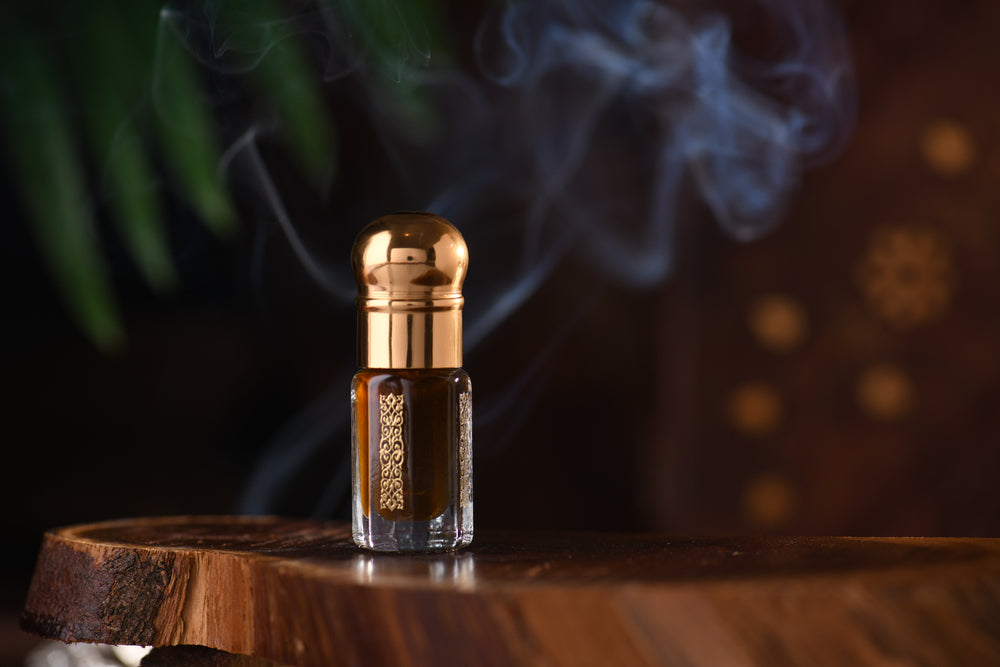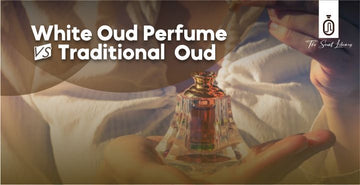Do you love fragrances that whisk you away to far-off places? If you do, you've probably encountered the magical world of oud perfumes. Oud, also known as agarwood, has been cherished for centuries for its wonderful woody scent.
It's like a timeless symbol, especially loved in the Middle East. People have admired this special smell for years because of its rich and complex aroma. In the United Arab Emirates, oud is not just a smell; it's a story and something that families pass down.
But now, there's a new player in town – White Oud Perfume.
In this blog post, we'll take you on a scented journey to explore the differences between White Oud and Traditional Oud. We'll talk about what makes them special, where they come from, and why people in the UAE really love them. Let's get started!
Traditional Oud: The Classic Scent

The scent of traditional oud is like no other – a complex symphony of deep, warm, and woody notes with hints of smoky, earthy, and sweet undertones. It is a scent that lingers, evoking a sense of mystery and luxury. In the world of perfumery, traditional oud is renowned for its depth and longevity, a fragrance that evolves on the skin, revealing different facets over time.
In Middle Eastern culture, traditional oud is more than a perfume; it is a reflection of identity and heritage. It is often used on special occasions, in religious ceremonies, and as a welcoming gesture in homes. The rich, enveloping aroma of traditional oud creates an ambiance of warmth and hospitality, a scent that is both comforting and exotic.
Origin of Oud
Oud, also known as agarwood or aloeswood, is a fragrant resinous wood derived from the Aquilaria tree. The magical essence of traditional oud lies in the heartwood of this tree, which is formed as a response to fungal and bacterial infections. The wood undergoes a transformative process, becoming dark, resinous, and highly aromatic.
The journey of oud begins in the dense forests where the Aquilaria tree, the source of oud, grows. When infected by a particular mold, the heartwood of this tree undergoes a remarkable transformation, producing a resin-rich, fragrant wood known as oud or agarwood. This process, a beautiful interplay of nature and chance, gives birth to a scent that has been cherished for millennia.
Extraction Process
The extraction of traditional oud is a painstaking and time-consuming process. It involves the harvesting of infected Aquilaria trees, followed by the careful removal of the resinous heartwood.
The extracted resin is then distilled or soaked in water to obtain the precious oud oil. This labor of love contributes to the rarity and value of traditional oud, often referred to as 'liquid gold' in the fragrance world.
Characteristics of OUD
Traditional oud is renowned for its complex and multifaceted scent profile. It offers a rich, deep, and woody aroma with sweetness, spice, and earthiness hints. The fragrance is often described as resinous, smoky, and animalic, making it both captivating and enigmatic.
OUD Historical and Cultural Significance
The origin of oud can be traced back to various regions in Asia, including India, Cambodia, and Malaysia. The best-quality oud is believed to come from the Indian subcontinent, where the Aquilaria tree is abundant.
Historically, the oud has been a symbol of luxury and spirituality in Middle Eastern culture. It has been used for centuries in religious ceremonies, traditional medicine, and perfumery. Oud is often associated with luxury and prestige, making it an integral part of special occasions and celebrations.
Keynotes and Common Combinations in OUD Perfumery
Perfumers use oud as a base note to create a wide range of fragrances. Its versatility allows it to be paired with various other notes, including floral, citrus, and spicy elements. Some popular combinations include Oud and Rose, Oud and Sandalwood, and Oud and Saffron. These combinations create unique and captivating scents that appeal to different preferences.
White OUD Perfume: A Modern Twist

White Oud represents a new horizon in the world of oud fragrances. It is a lighter, more contemporary version of traditional oud, crafted to suit the evolving tastes of modern perfume enthusiasts. White OUD Perfume retains the essence of oud but introduces a fresher, softer approach. This variation often includes floral, fruity, or citrus notes, creating a scent that is accessible and versatile.
The appeal of White Oud lies in its ability to bridge tradition and modernity. It offers a gentle introduction to the world of oud for those who might find the traditional version too intense. Its versatility makes it suitable for various occasions, from casual outings to formal events, appealing to a wide range of perfume lovers, especially the younger generation.
Origin and Development of White Oud
White Oud, often referred to as "Oud Blanc" or "White Wood," is a relatively new entrant to the world of perfumery. Unlike traditional oud, White Oud does not involve the infection of the Aquilaria tree. Instead, it is obtained from the heartwood of healthy Aquilaria trees, which yields a lighter and less resinous wood.
Extraction Process and Ingredients
White Oud sets itself apart by utilizing a different extraction process and the heartwood of healthy trees. This results in a wood that is notably lighter in color compared to its traditional counterpart. The absence of infection means that White Oud lacks the deep resinous character found in traditional oud.
Characteristics of White Oud
White Oud offers a more delicate and refined scent profile compared to traditional oud. It is characterized by a lighter, slightly floral, and creamy aroma. This fragrance is less overpowering, making it suitable for those who prefer subtler scents. White Oud is often associated with a sense of purity and elegance.
Scent Profile, Intensity, and Longevity
The scent profile of White Oud is often described as airy, woody, and slightly sweet. It lacks the intense smokiness and animalic notes found in traditional oud. Due to its lighter nature, White Oud tends to have longevity on the skin.
Cultural Significance and Usage
Oud has a special place in Middle Eastern culture. Its use transcends mere personal fragrance; it is a part of daily life and rituals. Traditional oud is often used in religious and cultural ceremonies, symbolizing purity, spirituality, and tradition. It is also a popular gift, reflecting respect and generosity.
White Oud, while relatively new, has quickly gained popularity. It is seen as a modern, everyday fragrance, appealing to those who appreciate the heritage of oud but prefer a lighter scent. It is commonly used in personal grooming products, home fragrances, and as a sophisticated yet approachable personal scent.
Key Differences Between Traditional Oud and White Oud Perfume

1. Health and Skin Benefits
Apart from its mesmerizing scent, oud oil is believed to have therapeutic properties. It is often used in aromatherapy for its calming and relaxing effects. Some also attribute skin-healing properties to oud, though these benefits may vary between traditional and White Oud. White Oud's lighter formulation may be more suitable for those with sensitive skin or for everyday use.
2. Different Target Markets and Occasions
Traditional oud is favored for formal events and special occasions and when making a strong, lasting impression. It is especially popular during weddings, celebrations, and religious ceremonies. On the other hand, White Oud is well-suited for daily wear, office settings, and casual outings due to its lighter and less intrusive scent.
3. Insights from Consumers and Industry Experts
Leading perfumers and industry experts in the UAE have noted a growing trend towards White Oud, especially among younger consumers and those seeking modern, everyday fragrances. Traditional oud continues to have a strong presence in luxury perfume collections and remains a symbol of prestige.
4. Price and Accessibility
The rarity and quality of the ingredients influence the cost of oud-based perfumes. Due to their intricate production process and scarcity of high-quality oud, traditional oud perfumes are often priced at a premium. White Oud, on the other hand, is generally more affordable.
Its production, involving blending and modern extraction techniques, allows for a wider availability. Both traditional and White Oud perfumes are widely available in the UAE, with many luxury and boutique perfume houses offering a range of options for enthusiasts.
5. Sustainability and Ethical Sourcing
In recent years, there has been a significant emphasis on sustainability and ethical sourcing within the perfume industry. Traditional oud has faced challenges related to over-harvesting Aquilaria trees, leading to conservation efforts and sustainable cultivation practices. White Oud, derived from healthy trees, aligns more closely with sustainable practices.
How to Choose the Right Oud for You?

Perfume selection is never been easy and requires special consideration when choosing one. Same as this, selecting the right oud perfume can be a delightful journey of discovery. For those new to oud, it's essential to understand the distinction between authentic and synthetic oud scents. To help you choose between White Oud and traditional oud, let's conduct a side-by-side comparison:
- Scent Profile: Traditional oud offers a complex and intense scent with smoky and animalic notes, while White Oud has a lighter, more delicate, and slightly floral fragrance.
- Longevity: Traditional oud typically has longer longevity on the skin compared to White Oud.
- Versatility: White Oud is more versatile for everyday wear and suitable for those who prefer subtler fragrances, whereas traditional oud is often reserved for special occasions or those who appreciate stronger scents.
FAQs
What is the difference between oud and regular perfume?
Oud possesses an incredibly potent and enduring scent, which is why it is typically incorporated sparingly to enhance the intricacy and richness of fragrances. Oud is typically present in perfumes at significantly higher concentrations than what is typical for regular perfumes.
What does white Oud perfume smell like?
White Oud initiates its composition with a gentle blend of saffron, grapefruit, and nutmeg, followed by the prominent presence of patchouli at its core. Finally, the foundation concludes with a rich combination of Agarwood, oud, Amber, and Cambodian oud.


